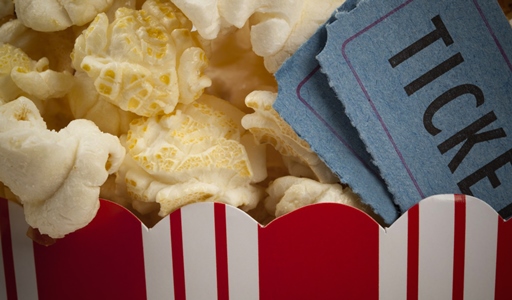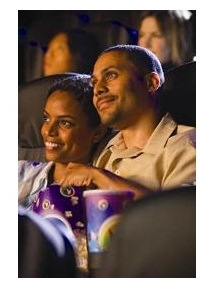American Moviegoers – Those Wonderful People Out There in the Dark - Cliff Marks

Whether or not your pick for Best Picture or Best Actress won an Oscar last night, I think we can all agree that the Academy Awards are always an exciting way for both fans and the industry to reflect on the very best of cinema.
Year after year, the movies are America's number one entertainment destination, and 2012 was Hollywood's biggest year ever. U.S. Box Office reached $10.83 billion, up 6.5% over 2011, and attendance was up 6.3% as moviegoers flocked to theaters to see everything from "Lincoln" and "Les Misérables" to "Ted" and "Frankenweenie" – once again proving that there truly is something for everyone at the movies.
ABC touted sold out ad inventory at record prices for last night's Oscars telecast, and it's nowonder that advertisers are clamoring to reach movie fans. According to the latest research from Nielsen NRG's 2012 American Moviegoing report, the most exciting story at the movies last year was not on the big screen, but in the audience.
There is an old film business saying that, as long as kids want to get away from parents and parents want a break from the kids, people will always go to the movies. In 2012, over 70% of Americans ages 12 and older saw a film on the big screen. In great news for exhibitors, the majority of moviegoers reported that they prefer to see films in a theater for reasons ranging from the distraction-free environment to the fact that it is a great excuse to get out of the house and spend time with family and friends. Movies are still one of the most economical entertainment options around, with an average ticket price of $7.96. In the minds of today's audiences, the perceived entertainment value of seeing a film in the theater considerably outweighs the value of buying DVDs/Blu-Rays, Redbox rentals, subscription rentals or streaming.
• As you might expect, younger moviegoers ages 12‐34, who represent 39% of the population, account for 53% of all ticket sales. But older adults are catching up – the proportion of moviegoers ages 65-74 from the Baby Boomers generation has been gradually growing at the expense of middle-aged moviegoers. Although there were slightly more female than male moviegoers in 2012 (51% and 49%, respectively), men accounted for 55% of theatrical attendance last year.
ages 65-74 from the Baby Boomers generation has been gradually growing at the expense of middle-aged moviegoers. Although there were slightly more female than male moviegoers in 2012 (51% and 49%, respectively), men accounted for 55% of theatrical attendance last year.
• In a Hollywood plot twist, Hispanics were the heaviest and most frequent moviegoers in 2012, accounting for 25% of all movie tickets sold even though they are only 15% of the U.S. population. Over 86% of this dedicated group of fans agree that it is important to go to the movies for the social experience (trending 12% higher than non-Hispanics), so it should come as no surprise that Hispanics are the most likely demographic to go to the movies in groups of four or more.
• When it comes to technology, moviegoers were way ahead of the mobile device curve with a far higher penetration of smartphones and tablets than the general public. Overall, mobile-connected moviegoers are even bigger film enthusiasts than the average person and are considerably more likely to have spent up to 35% more on entertainment in the past month. They like to text, tweet or post right after seeing a movie, and were also much more likely to buy tickets online, to see a movie on opening weekend, to see a film more than once, and to see it in 3-D in 2012.
• Speaking of 3-D, the Nielsen report also revealed that audiences have developed a true appetite for the third dimension. A clear majority of moviegoers (63%) who saw a 3-D movie within the past year said they are likely to seek out future movies in 3-D. Indeed, 4 out of 10 said that seeing a movie in 3-D is important enough to them that they would wait for another time or go to another theater if their intended 3-D showing was sold out.
All of this data certainly bodes well for the future of American moviegoing, and ensures that The Academy of Motion Picture Arts and Sciences will be handing out Oscars for many more years to come. But, while we all know that millions of people tuned in to watch the 85th Academy Awards on the ABC network last night, you might not know that there's a good chance that many of the people in that same audience also went to movies this weekend. In fact, according to Nielsen, cinema is the number one "network" in the country on weekends – beating out all TV and cable networks on Fridays and Saturdays every month of the year in 2012 in terms of reach.
TV and cinema have always had a symbiotic relationship, with TV networks using cinema advertising to reach entertainment audiences on weekends and studios using TV spots during the week to sell movie tickets. According to research conducted by the Cinema Advertising Council (CAC) member NCM Media Networks, the moviegoing experience has been shown to have a very positive influence on the audiences' emotional response to all advertising, and also has been proven to greatly enhance a consumer's ability to recall and enjoy ads. That's why so many marketers have discovered that combining cinema with a TV or other sight-sound-and-motion video buy leads to significantly greater impact and ROI across all advertising metrics.
So the next time you think about the movies, think about all of those wonderful people out there in the dark. There's no remote control or other MIGA (Make It Go Away) device in their hands – just a large popcorn and a Coke. They're engaged, enthusiastic, social, mobile and waiting to be entertained. Is your brand ready for its close-up?


